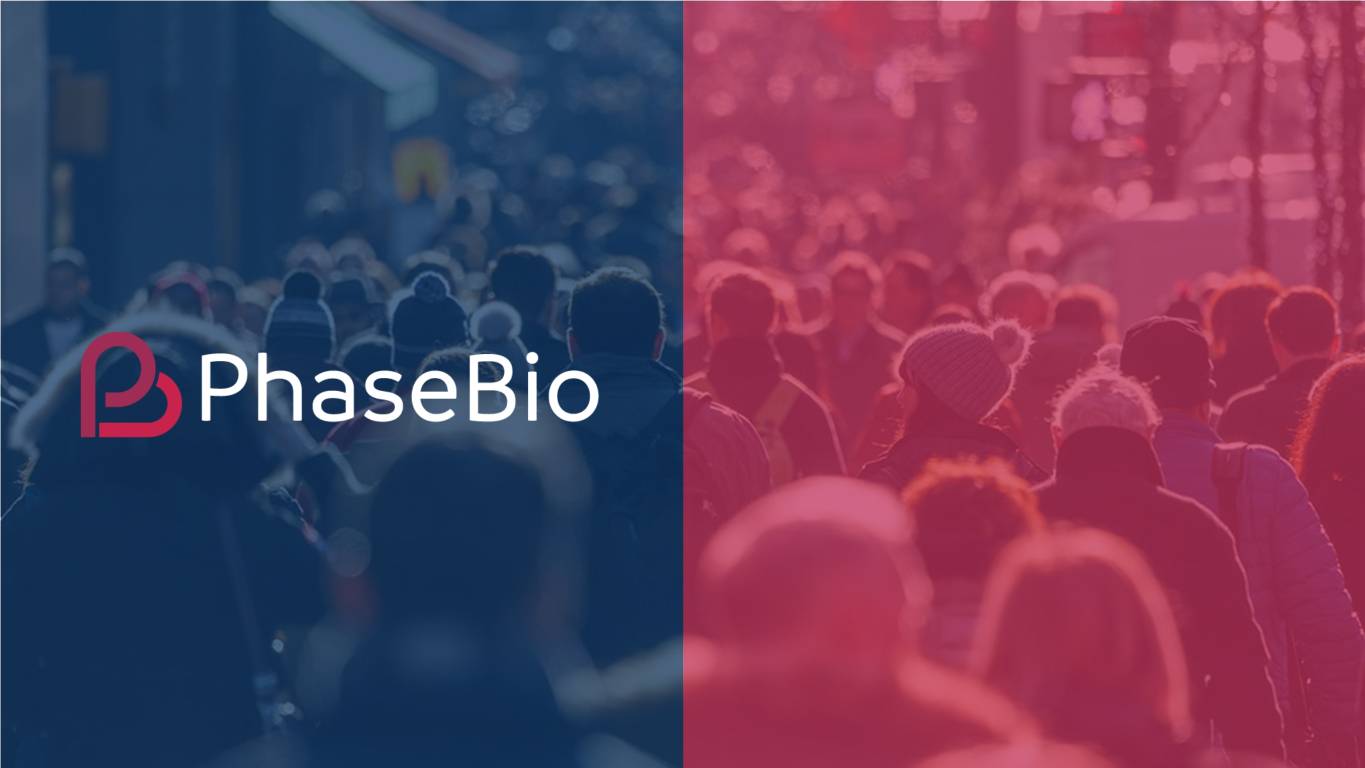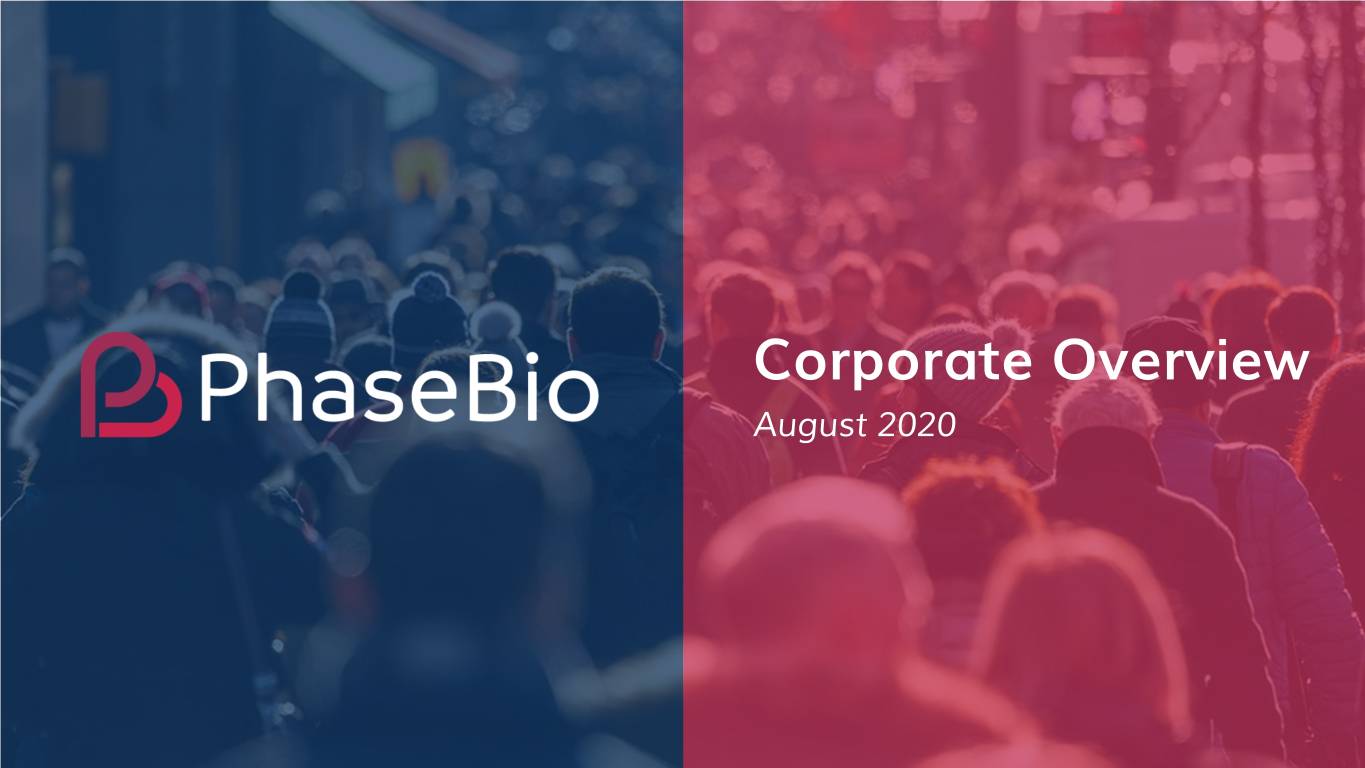
Corporate Overview August 2020
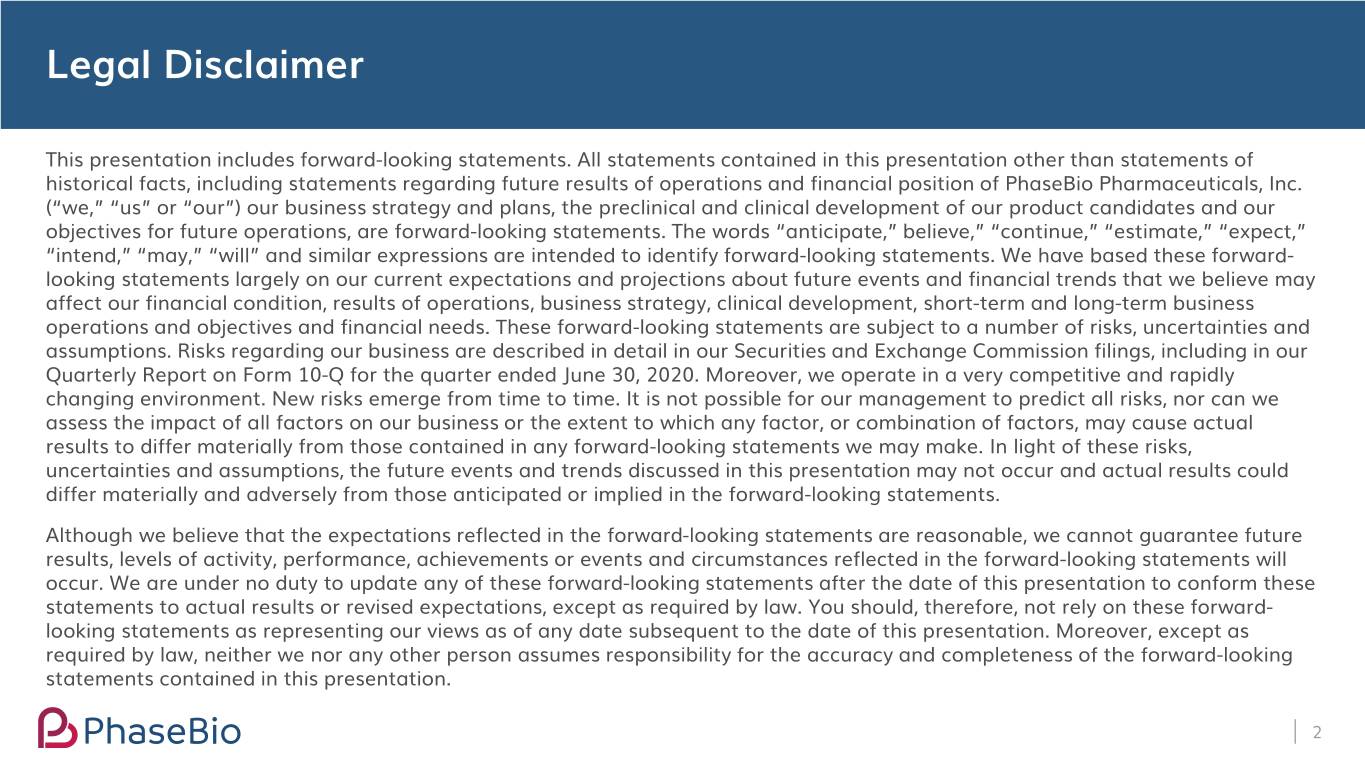
Legal Disclaimer This presentation includes forward-looking statements. All statements contained in this presentation other than statements of historical facts, including statements regarding future results of operations and financial position of PhaseBio Pharmaceuticals, Inc. (“we,” “us” or “our”) our business strategy and plans, the preclinical and clinical development of our product candidates and our objectives for future operations, are forward-looking statements. The words “anticipate,” believe,” “continue,” “estimate,” “expect,” “intend,” “may,” “will” and similar expressions are intended to identify forward-looking statements. We have based these forward- looking statements largely on our current expectations and projections about future events and financial trends that we believe may affect our financial condition, results of operations, business strategy, clinical development, short-term and long-term business operations and objectives and financial needs. These forward-looking statements are subject to a number of risks, uncertainties and assumptions. Risks regarding our business are described in detail in our Securities and Exchange Commission filings, including in our Quarterly Report on Form 10-Q for the quarter ended June 30, 2020. Moreover, we operate in a very competitive and rapidly changing environment. New risks emerge from time to time. It is not possible for our management to predict all risks, nor can we assess the impact of all factors on our business or the extent to which any factor, or combination of factors, may cause actual results to differ materially from those contained in any forward-looking statements we may make. In light of these risks, uncertainties and assumptions, the future events and trends discussed in this presentation may not occur and actual results could differ materially and adversely from those anticipated or implied in the forward-looking statements. Although we believe that the expectations reflected in the forward-looking statements are reasonable, we cannot guarantee future results, levels of activity, performance, achievements or events and circumstances reflected in the forward-looking statements will occur. We are under no duty to update any of these forward-looking statements after the date of this presentation to conform these statements to actual results or revised expectations, except as required by law. You should, therefore, not rely on these forward- looking statements as representing our views as of any date subsequent to the date of this presentation. Moreover, except as required by law, neither we nor any other person assumes responsibility for the accuracy and completeness of the forward-looking statements contained in this presentation. 2
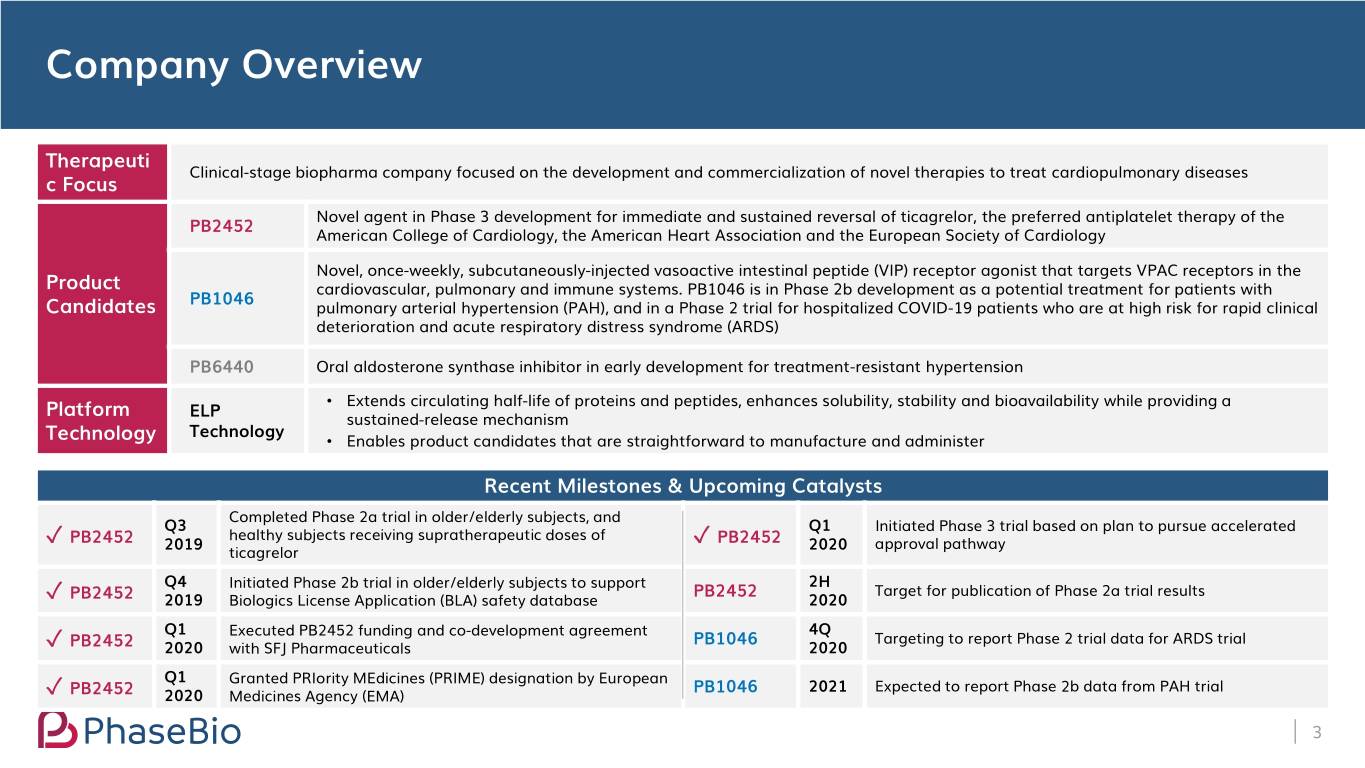
Company Overview Therapeuti Clinical-stage biopharma company focused on the development and commercialization of novel therapies to treat cardiopulmonary diseases c Focus Novel agent in Phase 3 development for immediate and sustained reversal of ticagrelor, the preferred antiplatelet therapy of the PB2452 American College of Cardiology, the American Heart Association and the European Society of Cardiology Novel, once-weekly, subcutaneously-injected vasoactive intestinal peptide (VIP) receptor agonist that targets VPAC receptors in the Product cardiovascular, pulmonary and immune systems. PB1046 is in Phase 2b development as a potential treatment for patients with PB1046 Candidates pulmonary arterial hypertension (PAH), and in a Phase 2 trial for hospitalized COVID-19 patients who are at high risk for rapid clinical deterioration and acute respiratory distress syndrome (ARDS) PB6440 Oral aldosterone synthase inhibitor in early development for treatment-resistant hypertension • Extends circulating half-life of proteins and peptides, enhances solubility, stability and bioavailability while providing a Platform ELP sustained-release mechanism Technology Technology • Enables product candidates that are straightforward to manufacture and administer Recent Milestones & Upcoming Catalysts Completed Phase 2a trial in older/elderly subjects, and Q3 Q1 Initiated Phase 3 trial based on plan to pursue accelerated healthy subjects receiving supratherapeutic doses of PB2452 2019 PB2452 2020 approval pathway ✓ ticagrelor ✓ Q4 Initiated Phase 2b trial in older/elderly subjects to support 2H PB2452 Target for publication of Phase 2a trial results ✓ PB2452 2019 Biologics License Application (BLA) safety database 2020 Q1 Executed PB2452 funding and co-development agreement 4Q PB1046 Targeting to report Phase 2 trial data for ARDS trial ✓ PB2452 2020 with SFJ Pharmaceuticals 2020 Q1 Granted PRIority MEdicines (PRIME) designation by European PB1046 2021 Expected to report Phase 2b data from PAH trial ✓ PB2452 2020 Medicines Agency (EMA) 3
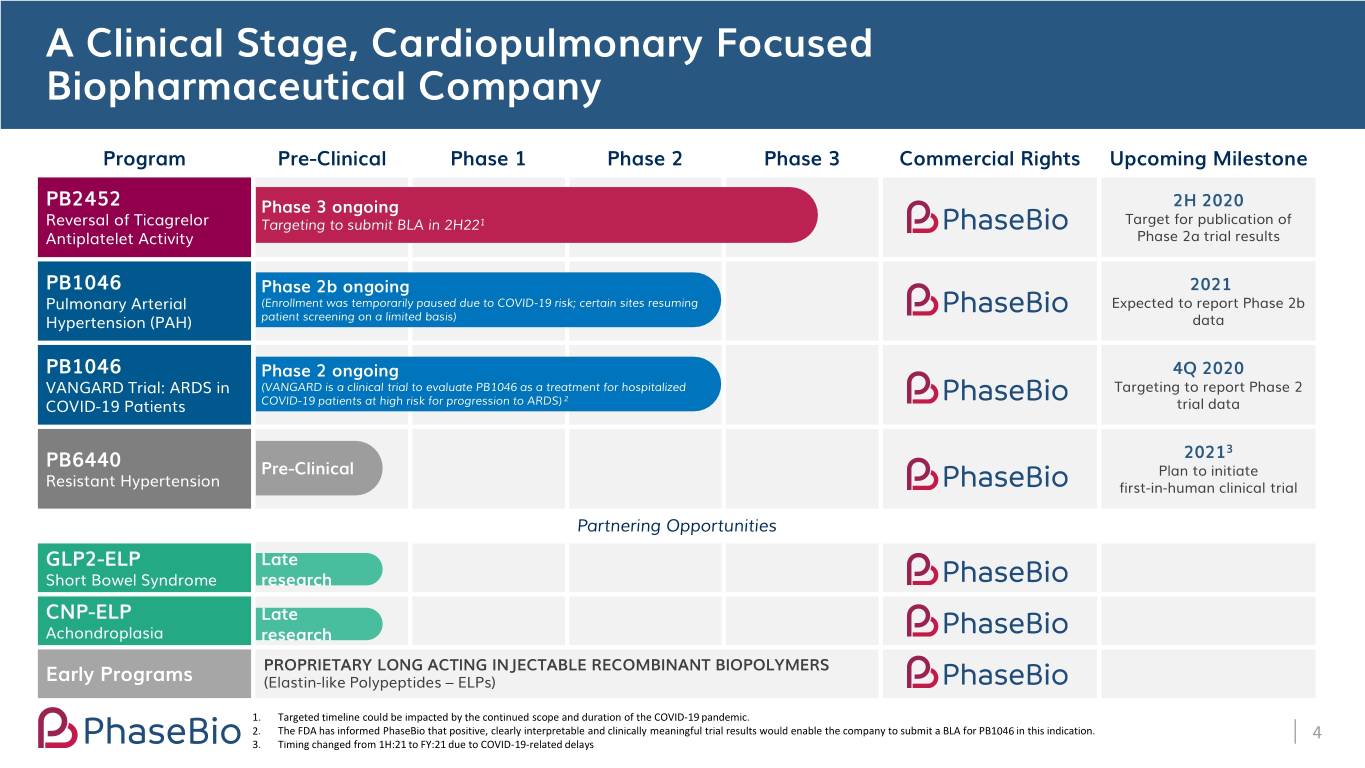
A Clinical Stage, Cardiopulmonary Focused Biopharmaceutical Company Program Pre-Clinical Phase 1 Phase 2 Phase 3 Commercial Rights Upcoming Milestone PB2452 Phase 3 ongoing 2H 2020 Reversal of Ticagrelor Targeting to submit BLA in 2H221 Target for publication of Antiplatelet Activity Phase 2a trial results PB1046 Phase 2b ongoing 2021 Pulmonary Arterial (Enrollment was temporarily paused due to COVID-19 risk; certain sites resuming Expected to report Phase 2b Hypertension (PAH) patient screening on a limited basis) data PB1046 Phase 2 ongoing 4Q 2020 VANGARD Trial: ARDS in (VANGARD is a clinical trial to evaluate PB1046 as a treatment for hospitalized Targeting to report Phase 2 2 COVID-19 Patients COVID-19 patients at high risk for progression to ARDS) trial data 20213 PB6440 Pre-Clinical Plan to initiate Resistant Hypertension first-in-human clinical trial Partnering Opportunities GLP2-ELP Late Short Bowel Syndrome research CNP-ELP Late Achondroplasia research PROPRIETARY LONG ACTING INJECTABLE RECOMBINANT BIOPOLYMERS Early Programs (Elastin-like Polypeptides – ELPs) 1. Targeted timeline could be impacted by the continued scope and duration of the COVID-19 pandemic. 2. The FDA has informed PhaseBio that positive, clearly interpretable and clinically meaningful trial results would enable the company to submit a BLA for PB1046 in this indication. 4 3. Timing changed from 1H:21 to FY:21 due to COVID-19-related delays

Corporate
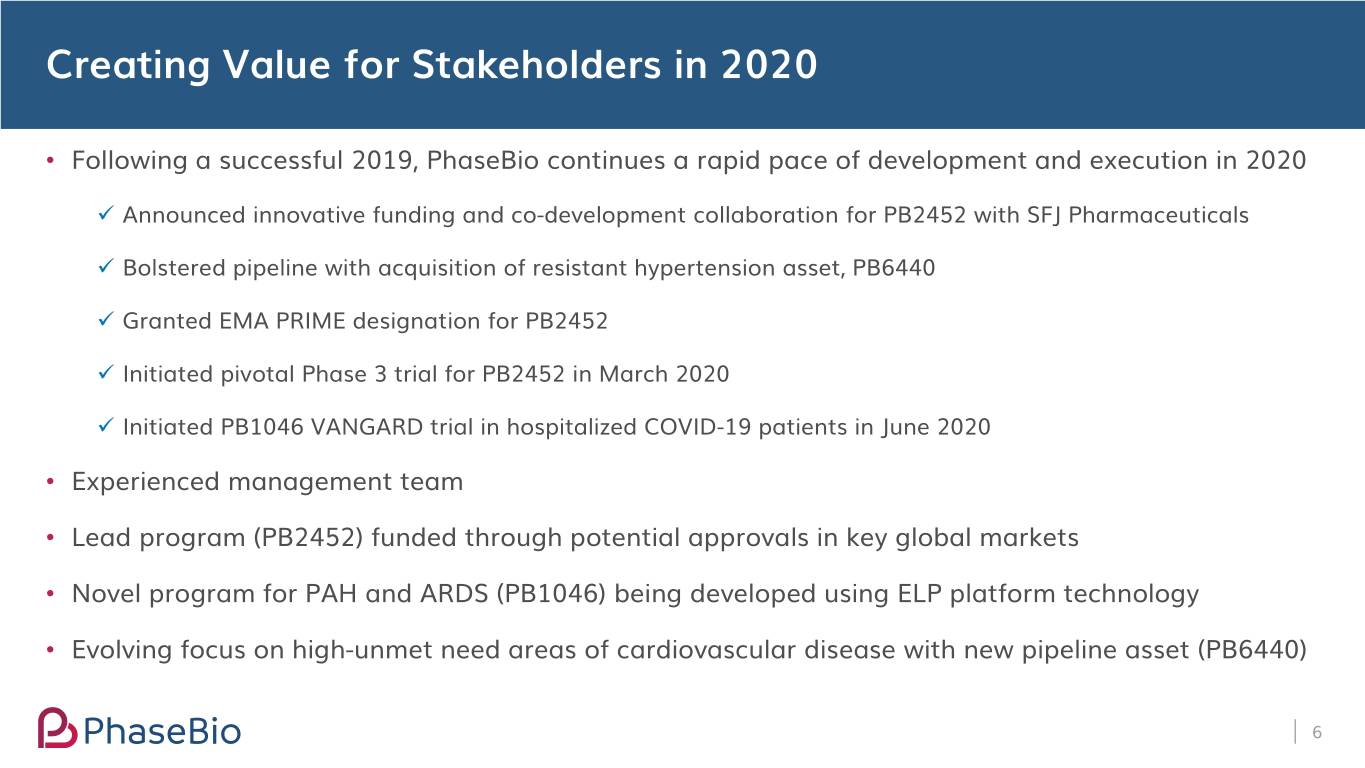
Creating Value for Stakeholders in 2020 • Following a successful 2019, PhaseBio continues a rapid pace of development and execution in 2020 Announced innovative funding and co-development collaboration for PB2452 with SFJ Pharmaceuticals Bolstered pipeline with acquisition of resistant hypertension asset, PB6440 Granted EMA PRIME designation for PB2452 Initiated pivotal Phase 3 trial for PB2452 in March 2020 Initiated PB1046 VANGARD trial in hospitalized COVID-19 patients in June 2020 • Experienced management team • Lead program (PB2452) funded through potential approvals in key global markets • Novel program for PAH and ARDS (PB1046) being developed using ELP platform technology • Evolving focus on high-unmet need areas of cardiovascular disease with new pipeline asset (PB6440) 6
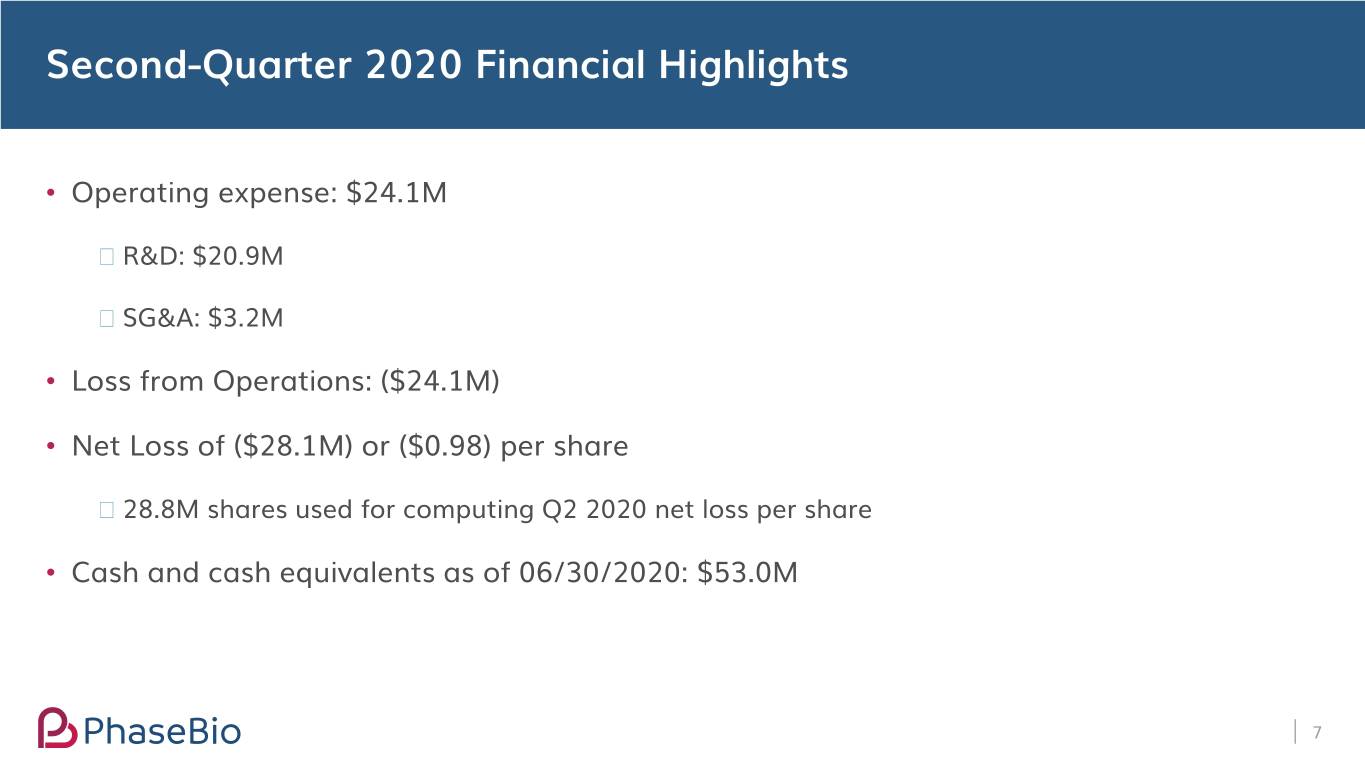
Second-Quarter 2020 Financial Highlights • Operating expense: $24.1M ⎯ R&D: $20.9M ⎯ SG&A: $3.2M • Loss from Operations: ($24.1M) • Net Loss of ($28.1M) or ($0.98) per share ⎯ 28.8M shares used for computing Q2 2020 net loss per share • Cash and cash equivalents as of 06/30/2020: $53.0M 7
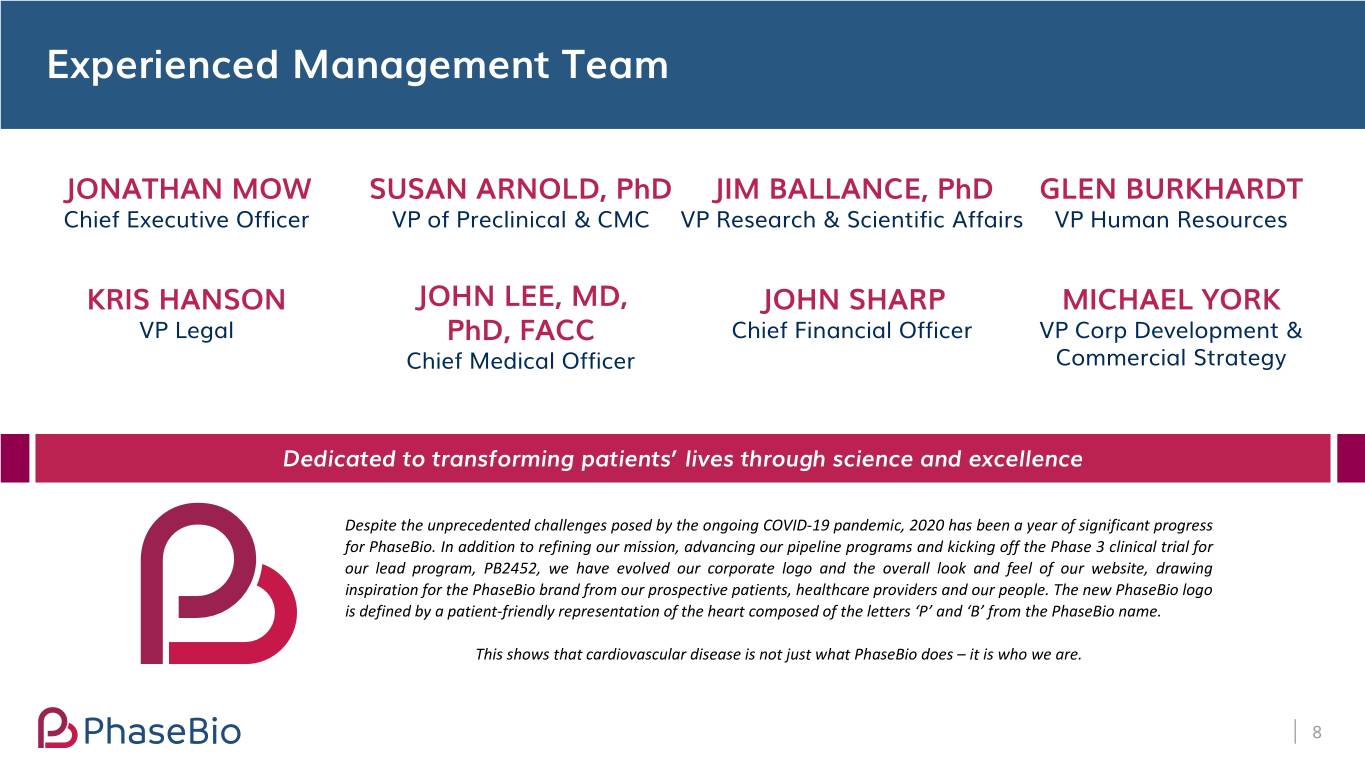
Experienced Management Team JONATHAN MOW SUSAN ARNOLD, PhD JIM BALLANCE, PhD GLEN BURKHARDT Chief Executive Officer VP of Preclinical & CMC VP Research & Scientific Affairs VP Human Resources KRIS HANSON JOHN LEE, MD, JOHN SHARP MICHAEL YORK VP Legal PhD, FACC Chief Financial Officer VP Corp Development & Chief Medical Officer Commercial Strategy Dedicated to transforming patients’ lives through science and excellence Despite the unprecedented challenges posed by the ongoing COVID-19 pandemic, 2020 has been a year of significant progress for PhaseBio. In addition to refining our mission, advancing our pipeline programs and kicking off the Phase 3 clinical trial for our lead program, PB2452, we have evolved our corporate logo and the overall look and feel of our website, drawing inspiration for the PhaseBio brand from our prospective patients, healthcare providers and our people. The new PhaseBio logo is defined by a patient-friendly representation of the heart composed of the letters ‘P’ and ‘B’ from the PhaseBio name. This shows that cardiovascular disease is not just what PhaseBio does – it is who we are. 8

PB2452 Reversal Agent for Ticagrelor
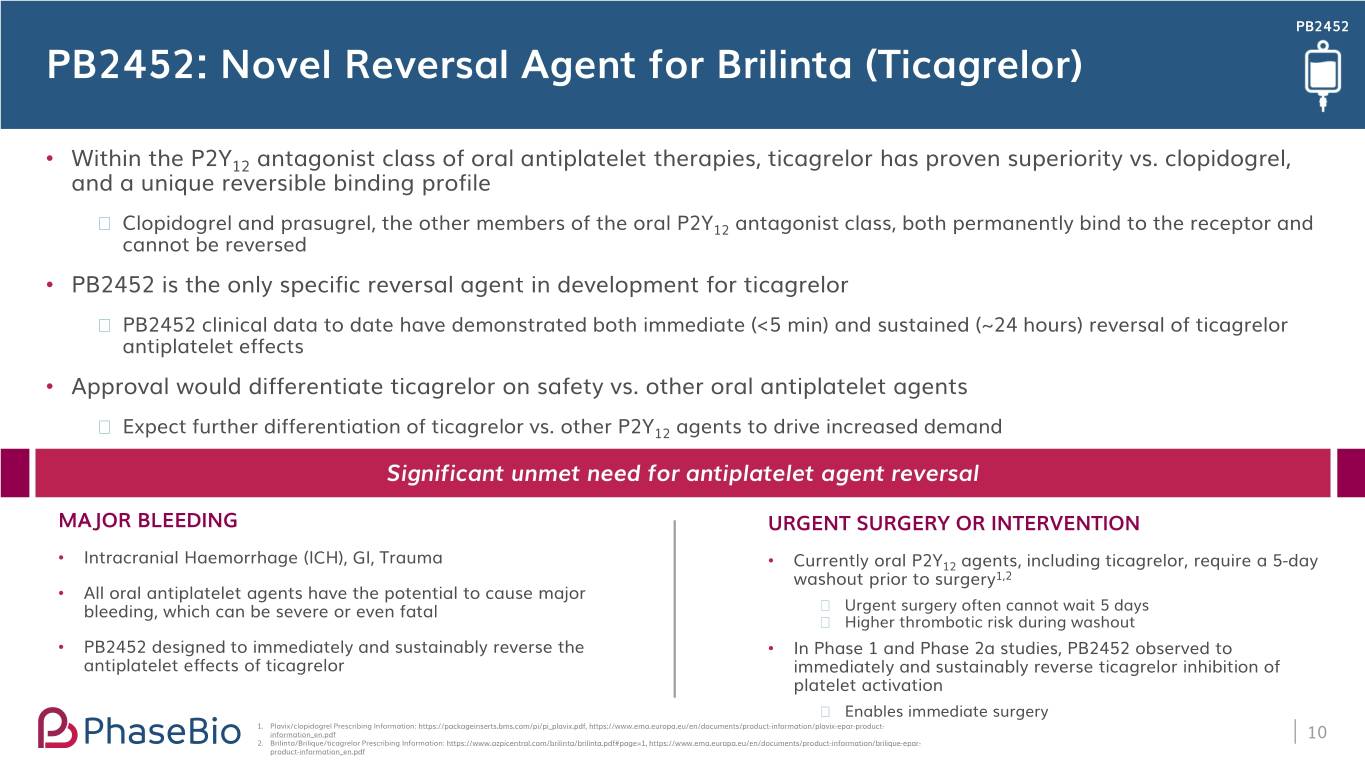
PB2452 PB2452: Novel Reversal Agent for Brilinta (Ticagrelor) • Within the P2Y12 antagonist class of oral antiplatelet therapies, ticagrelor has proven superiority vs. clopidogrel, and a unique reversible binding profile ⎯ Clopidogrel and prasugrel, the other members of the oral P2Y12 antagonist class, both permanently bind to the receptor and cannot be reversed • PB2452 is the only specific reversal agent in development for ticagrelor ⎯ PB2452 clinical data to date have demonstrated both immediate (<5 min) and sustained (~24 hours) reversal of ticagrelor antiplatelet effects • Approval would differentiate ticagrelor on safety vs. other oral antiplatelet agents ⎯ Expect further differentiation of ticagrelor vs. other P2Y12 agents to drive increased demand Significant unmet need for antiplatelet agent reversal MAJOR BLEEDING URGENT SURGERY OR INTERVENTION • Intracranial Haemorrhage (ICH), GI, Trauma • Currently oral P2Y12 agents, including ticagrelor, require a 5-day washout prior to surgery1,2 • All oral antiplatelet agents have the potential to cause major bleeding, which can be severe or even fatal ⎯ Urgent surgery often cannot wait 5 days ⎯ Higher thrombotic risk during washout • PB2452 designed to immediately and sustainably reverse the • In Phase 1 and Phase 2a studies, PB2452 observed to antiplatelet effects of ticagrelor immediately and sustainably reverse ticagrelor inhibition of platelet activation ⎯ Enables immediate surgery 1. Plavix/clopidogrel Prescribing Information: https://packageinserts.bms.com/pi/pi_plavix.pdf, https://www.ema.europa.eu/en/documents/product-information/plavix-epar-product- information_en.pdf 10 2. Brilinta/Brilique/ticagrelor Prescribing Information: https://www.azpicentral.com/brilinta/brilinta.pdf#page=1, https://www.ema.europa.eu/en/documents/product-information/brilique-epar- product-information_en.pdf

PB2452 PB2452: Well-Characterized Mechanism of Reversal of Ticagrelor 1. ADP binds to P2Y12 3. PB2452 binds to free ticagrelor 5. As free ticagrelor is eliminated, ADP can again receptor causing with very high affinity activate the P2Y12 receptor, restoring platelet platelet aggregation activity This is a reversible process with ticagrelor cycling on/off the P2Y12 receptors PB2452-ticagrelor binding is preferential to Ticagrelor binds to P2Y , inhibiting 12 ticagrelor-P2Y12 binding due to 100x higher ADP-induced platelet aggregation PB2452-ticagrelor is cleared from the bloodstream 2. 4. affinity (Ki 20 pM vs 2nM) 6. 11

PB2452 PB2452: Development and Regulatory Timelines* 2019 2020 2021 2022 2023 NEJM Phase 2a Phase 2b: Older and elderly subjects N=200, 150 randomized to receive PB2452 Breakthrough FDA EMA PRIME Phase 3 interim analysis for Accelerated Approval Post-approval completion of Phase 3 Therapy EOP1 Designation N=100, ~50 major bleeding subjects, ~50 urgent surgery subjects N=100, ~50 major bleeding subjects, ~50 urgent surgery subjects Targeting BLA Submission for Accelerated Approval Targeted timelines could be impacted by the continued scope and duration of the COVID-19 pandemic *Targeted timeline could be impacted by the continued scope and duration of the COVID-19 pandemic NEJM= New England Journal of Medicine, EOP1=End-of-Phase 1 Meeting, BLA=Biologics License Application • Phase 2b initiated in October 2019 ⎯ N=200 total, evaluation of efficacy and overall safety of PB2452 in older and elderly subjects on dual antiplatelet therapy • Phase 3 initiated in March 2020 ⎯ N=200 total, evaluation of efficacy in ticagrelor-treated subjects with major bleeding events or requiring urgent surgery ⎯ Interim analysis of first ~100 patients recommended by FDA for BLA submission for Accelerated Approval 12
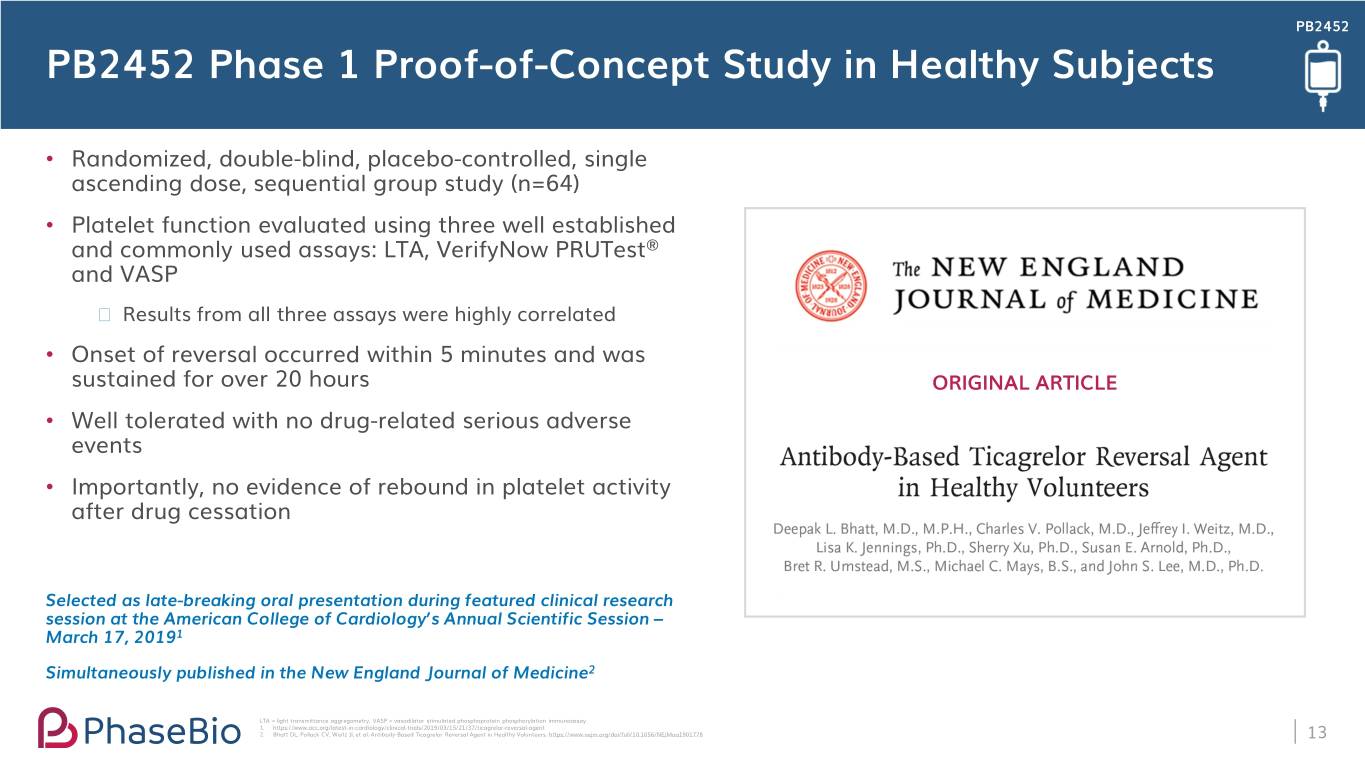
PB2452 PB2452 Phase 1 Proof-of-Concept Study in Healthy Subjects • Randomized, double-blind, placebo-controlled, single ascending dose, sequential group study (n=64) • Platelet function evaluated using three well established and commonly used assays: LTA, VerifyNow PRUTest® and VASP ⎯ Results from all three assays were highly correlated • Onset of reversal occurred within 5 minutes and was sustained for over 20 hours ORIGINAL ARTICLE • Well tolerated with no drug-related serious adverse events • Importantly, no evidence of rebound in platelet activity after drug cessation Selected as late-breaking oral presentation during featured clinical research session at the American College of Cardiology’s Annual Scientific Session – March 17, 20191 Simultaneously published in the New England Journal of Medicine2 LTA = light transmittance aggregometry, VASP = vasodilator stimulated phosphoprotein phosphorylation immunoassay 1. https://www.acc.org/latest-in-cardiology/clinical-trials/2019/03/15/21/37/ticagrelor-reversal-agent 2. Bhatt DL, Pollack CV, Weitz JI, et al. Antibody-Based Ticagrelor Reversal Agent in Healthy Volunteers. https://www.nejm.org/doi/full/10.1056/NEJMoa1901778 13
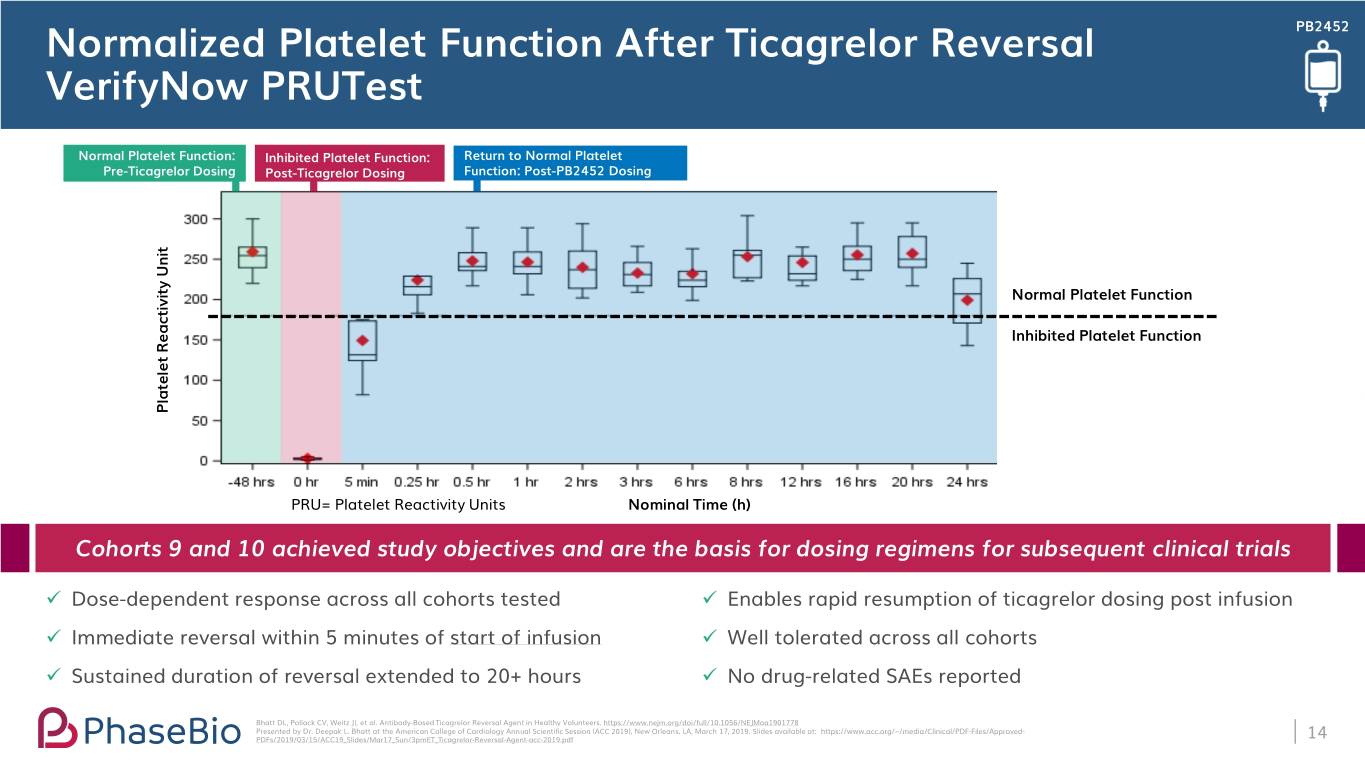
PB2452 Normalized Platelet Function After Ticagrelor Reversal VerifyNow PRUTest Normal Platelet Function: Inhibited Platelet Function: Return to Normal Platelet Pre-Ticagrelor Dosing Post-Ticagrelor Dosing Function: Post-PB2452 Dosing Normal Platelet Function Inhibited Platelet Function Platelet Reactivity Unit Reactivity Platelet PRU= Platelet Reactivity Units Nominal Time (h) Cohorts 9 and 10 achieved study objectives and are the basis for dosing regimens for subsequent clinical trials Dose-dependent response across all cohorts tested Enables rapid resumption of ticagrelor dosing post infusion Immediate reversal within 5 minutes of start of infusion Well tolerated across all cohorts Sustained duration of reversal extended to 20+ hours No drug-related SAEs reported Bhatt DL, Pollack CV, Weitz JI, et al. Antibody-Based Ticagrelor Reversal Agent in Healthy Volunteers. https://www.nejm.org/doi/full/10.1056/NEJMoa1901778 Presented by Dr. Deepak L. Bhatt at the American College of Cardiology Annual Scientific Session (ACC 2019), New Orleans, LA, March 17, 2019. Slides available at: https://www.acc.org/~/media/Clinical/PDF-Files/Approved- PDFs/2019/03/15/ACC19_Slides/Mar17_Sun/3pmET_Ticagrelor-Reversal-Agent-acc-2019.pdf 14
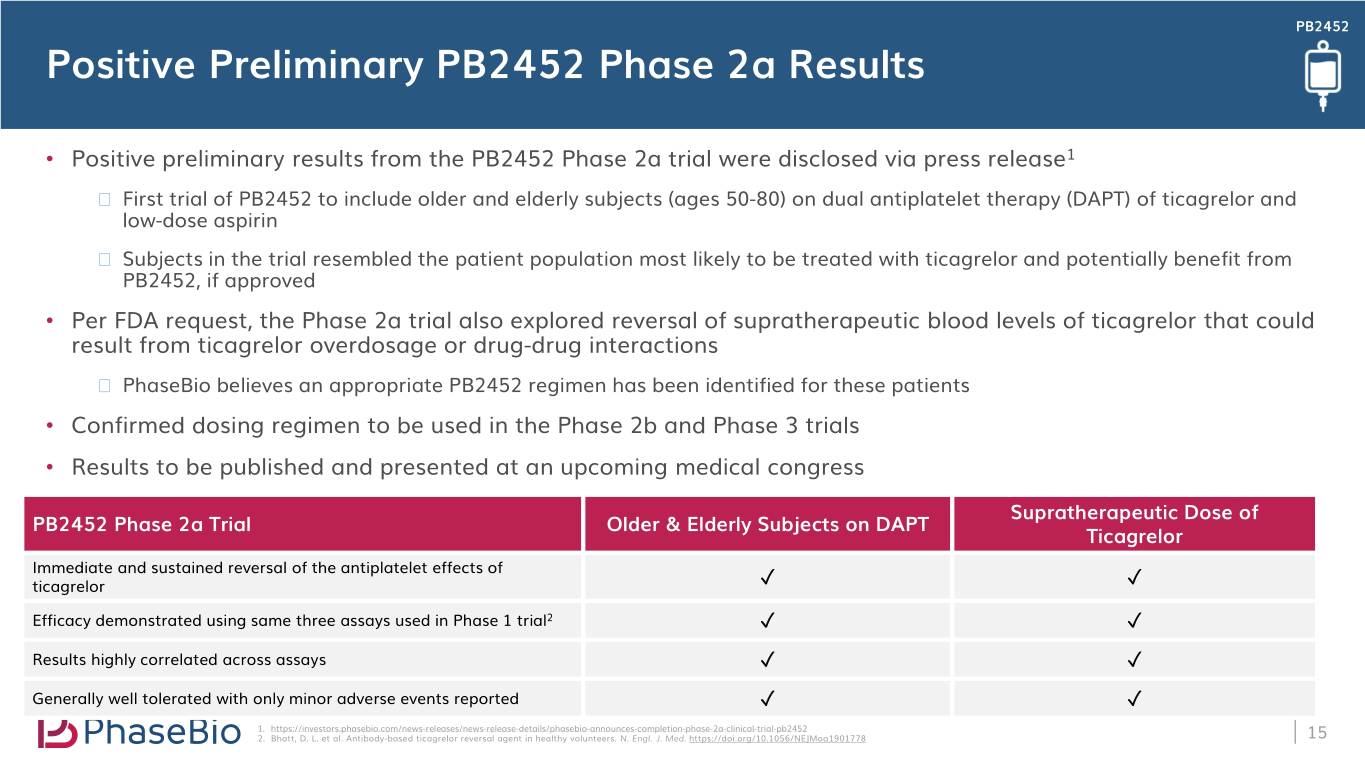
PB2452 Positive Preliminary PB2452 Phase 2a Results • Positive preliminary results from the PB2452 Phase 2a trial were disclosed via press release1 ⎯ First trial of PB2452 to include older and elderly subjects (ages 50-80) on dual antiplatelet therapy (DAPT) of ticagrelor and low-dose aspirin ⎯ Subjects in the trial resembled the patient population most likely to be treated with ticagrelor and potentially benefit from PB2452, if approved • Per FDA request, the Phase 2a trial also explored reversal of supratherapeutic blood levels of ticagrelor that could result from ticagrelor overdosage or drug-drug interactions ⎯ PhaseBio believes an appropriate PB2452 regimen has been identified for these patients • Confirmed dosing regimen to be used in the Phase 2b and Phase 3 trials • Results to be published and presented at an upcoming medical congress Supratherapeutic Dose of PB2452 Phase 2a Trial Older & Elderly Subjects on DAPT Ticagrelor Immediate and sustained reversal of the antiplatelet effects of ticagrelor ✓ ✓ Efficacy demonstrated using same three assays used in Phase 1 trial2 ✓ ✓ Results highly correlated across assays ✓ ✓ Generally well tolerated with only minor adverse events reported ✓ ✓ 1. https://investors.phasebio.com/news-releases/news-release-details/phasebio-announces-completion-phase-2a-clinical-trial-pb2452 2. Bhatt, D. L. et al. Antibody-based ticagrelor reversal agent in healthy volunteers. N. Engl. J. Med. https://doi.org/10.1056/NEJMoa1901778 15

PB2452 PB2452 Regulatory Updates Development plan for PB2452 designed with objective to broadly support global regulatory filings Separate written guidance from FDA and EMA indicates that a single, non-randomized, open-label Phase 3 trial of PB2452 in both surgical and major bleeding populations has the potential to support regulatory filings in the United States and the European Union EMA: FDA: • Received written Scientific Advice: February 2020 • Received meeting minutes from PB2452 End-of-Phase 1 meeting: August 2019 ⎯ Written guidance from the CHMP of the EMA generally agrees with PhaseBio’s proposed development plan for ⎯ FDA alignment on development plan and Accelerated PB2452 Approval regulatory path • Granted PRIME designation: February 2020 • PB2452 granted Breakthrough Therapy designation: April 2019 ⎯ PRIME designation is granted by the EMA to support medicines that demonstrate the potential to address ⎯ Breakthrough Therapy designation is designed to 1 substantial unmet medical need expedite the development and review of promising new drugs2 ⎯ Potentially expedites the review and approval process 1. The European Medicines Agency. “PRIME: Priority Medicines” Available at: https://www.ema.europa.eu/en/human-regulatory/research-development/prime-priority-medicines#. Accessed February 2020 2. The U.S. Food and Drug Administration. “Expedited Programs for Serious Conditions – Drugs and Biologics.” Available at: https://www.fda.gov/downloads/Drugs/Guidances/UCM358301.pdf. Accessed 16 February 2020
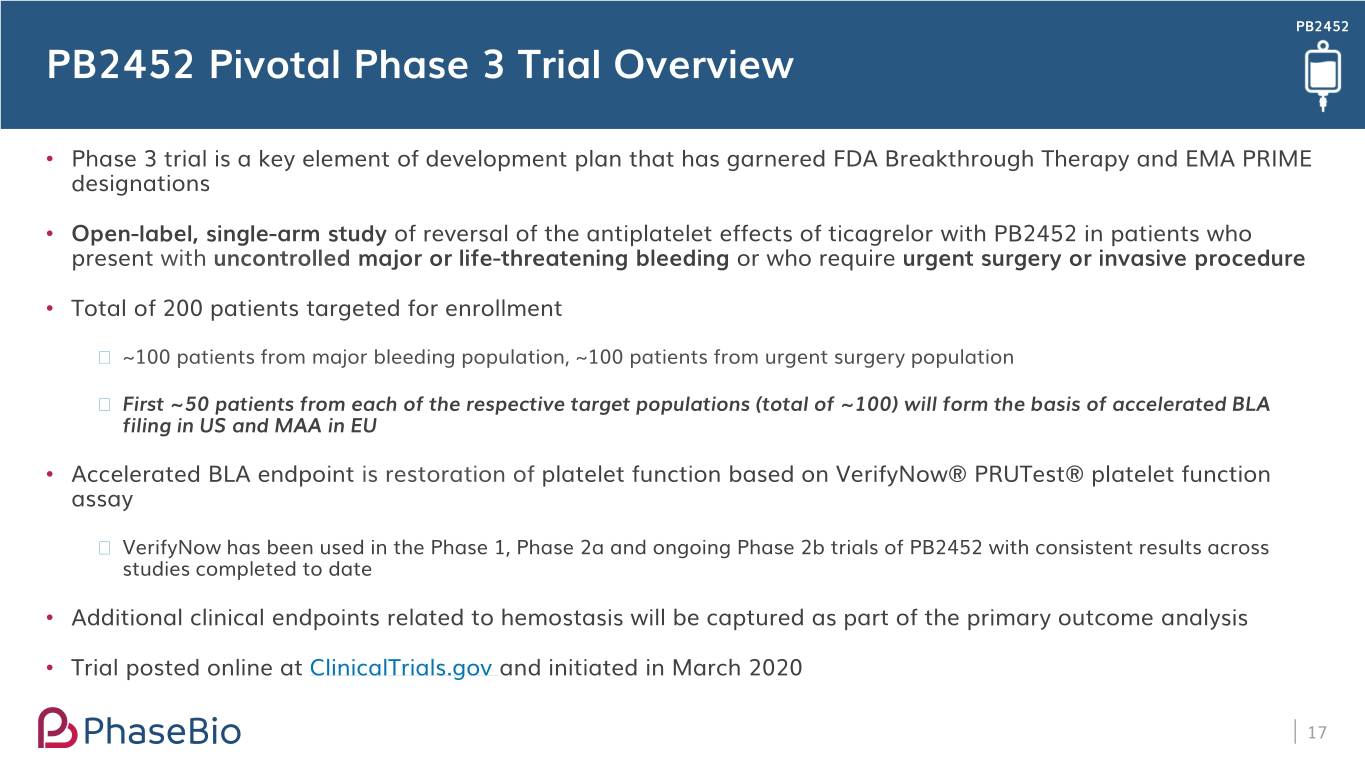
PB2452 PB2452 Pivotal Phase 3 Trial Overview • Phase 3 trial is a key element of development plan that has garnered FDA Breakthrough Therapy and EMA PRIME designations • Open-label, single-arm study of reversal of the antiplatelet effects of ticagrelor with PB2452 in patients who present with uncontrolled major or life-threatening bleeding or who require urgent surgery or invasive procedure • Total of 200 patients targeted for enrollment ⎯ ~100 patients from major bleeding population, ~100 patients from urgent surgery population ⎯ First ~50 patients from each of the respective target populations (total of ~100) will form the basis of accelerated BLA filing in US and MAA in EU • Accelerated BLA endpoint is restoration of platelet function based on VerifyNow® PRUTest® platelet function assay ⎯ VerifyNow has been used in the Phase 1, Phase 2a and ongoing Phase 2b trials of PB2452 with consistent results across studies completed to date • Additional clinical endpoints related to hemostasis will be captured as part of the primary outcome analysis • Trial posted online at ClinicalTrials.gov and initiated in March 2020 17
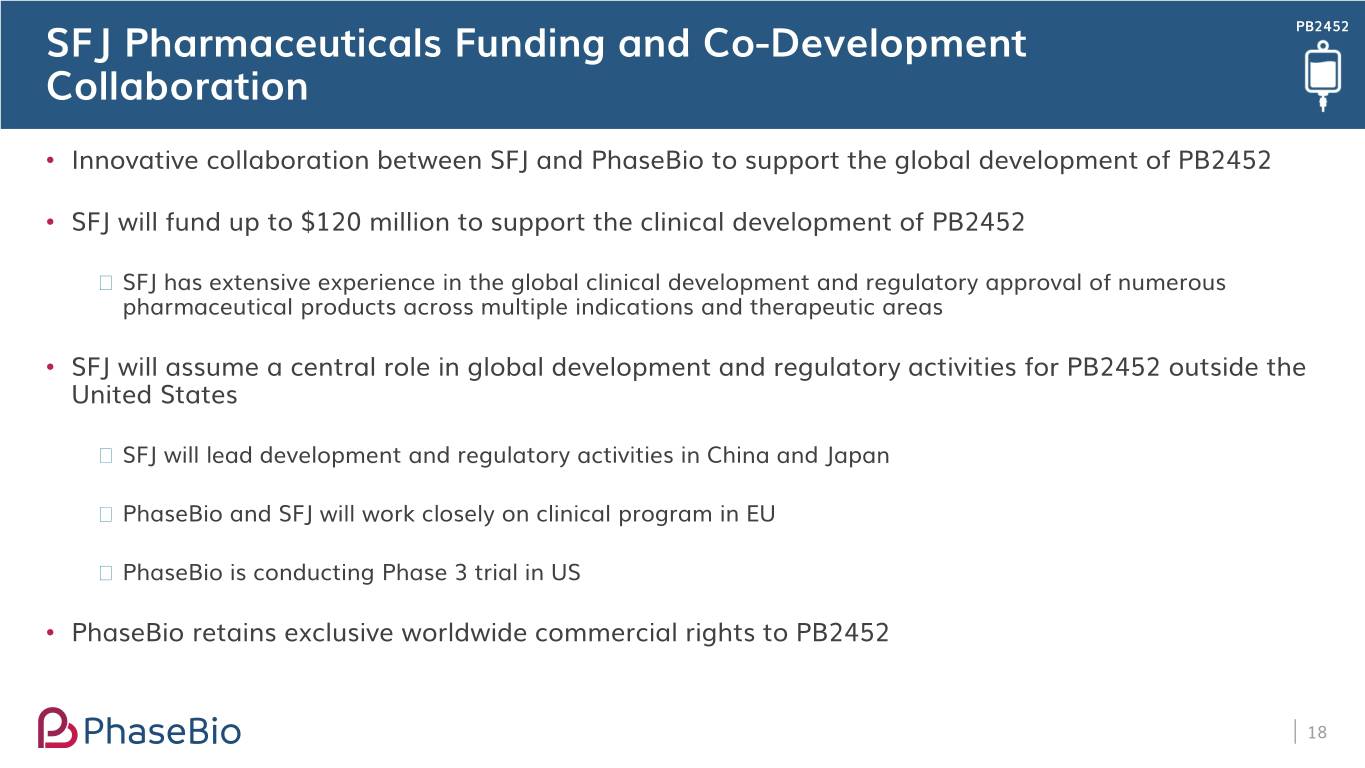
PB2452 SFJ Pharmaceuticals Funding and Co-Development Collaboration • Innovative collaboration between SFJ and PhaseBio to support the global development of PB2452 • SFJ will fund up to $120 million to support the clinical development of PB2452 ⎯ SFJ has extensive experience in the global clinical development and regulatory approval of numerous pharmaceutical products across multiple indications and therapeutic areas • SFJ will assume a central role in global development and regulatory activities for PB2452 outside the United States ⎯ SFJ will lead development and regulatory activities in China and Japan ⎯ PhaseBio and SFJ will work closely on clinical program in EU ⎯ PhaseBio is conducting Phase 3 trial in US • PhaseBio retains exclusive worldwide commercial rights to PB2452 18
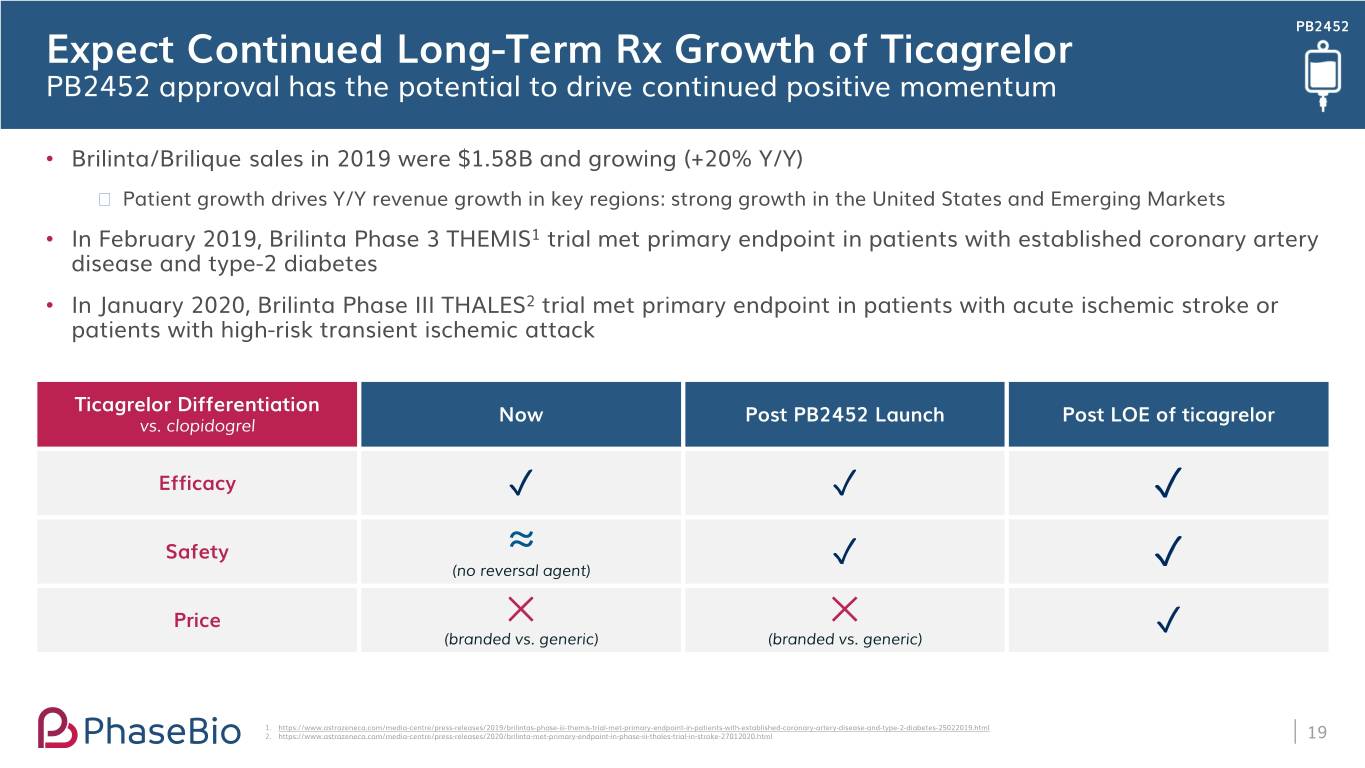
PB2452 Expect Continued Long-Term Rx Growth of Ticagrelor PB2452 approval has the potential to drive continued positive momentum • Brilinta/Brilique sales in 2019 were $1.58B and growing (+20% Y/Y) ⎯ Patient growth drives Y/Y revenue growth in key regions: strong growth in the United States and Emerging Markets • In February 2019, Brilinta Phase 3 THEMIS1 trial met primary endpoint in patients with established coronary artery disease and type-2 diabetes • In January 2020, Brilinta Phase III THALES2 trial met primary endpoint in patients with acute ischemic stroke or patients with high-risk transient ischemic attack Ticagrelor Differentiation Now Post PB2452 Launch Post LOE of ticagrelor vs. clopidogrel Efficacy ✓ ✓ ✓ Safety ≈ (no reversal agent) ✓ ✓ Price (branded✕vs. generic) (branded✕ vs. generic) ✓ 1. https://www.astrazeneca.com/media-centre/press-releases/2019/brilintas-phase-iii-themis-trial-met-primary-endpoint-in-patients-with-established-coronary-artery-disease-and-type-2-diabetes-25022019.html 2. https://www.astrazeneca.com/media-centre/press-releases/2020/brilinta-met-primary-endpoint-in-phase-iii-thales-trial-in-stroke-27012020.html 19

PB1046 Once Weekly Vasoactive Intestinal Peptide (VIP) Analog
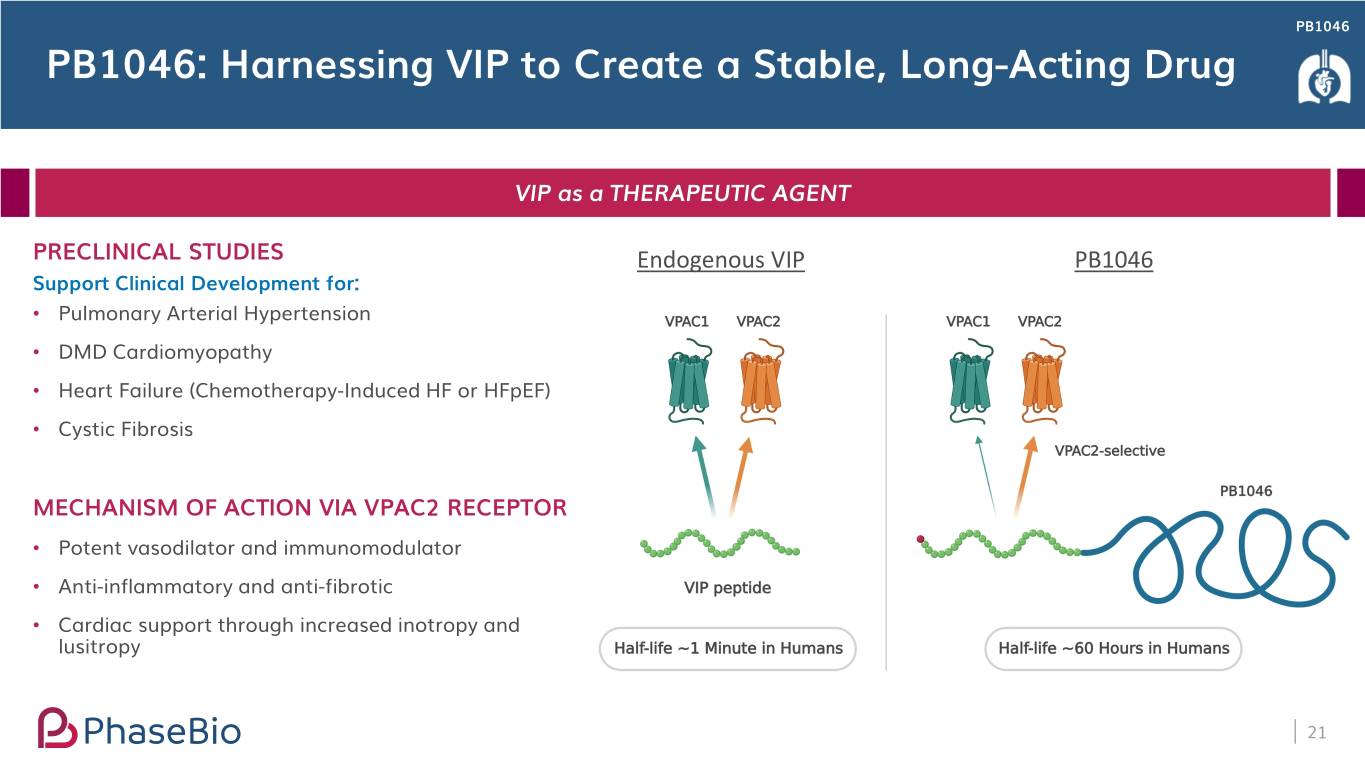
PB1046 PB1046: Harnessing VIP to Create a Stable, Long-Acting Drug VIP as a THERAPEUTIC AGENT PRECLINICAL STUDIES Endogenous VIP PB1046 Support Clinical Development for: • Pulmonary Arterial Hypertension • DMD Cardiomyopathy • Heart Failure (Chemotherapy-Induced HF or HFpEF) • Cystic Fibrosis MECHANISM OF ACTION VIA VPAC2 RECEPTOR • Potent vasodilator and immunomodulator • Anti-inflammatory and anti-fibrotic • Cardiac support through increased inotropy and lusitropy 21
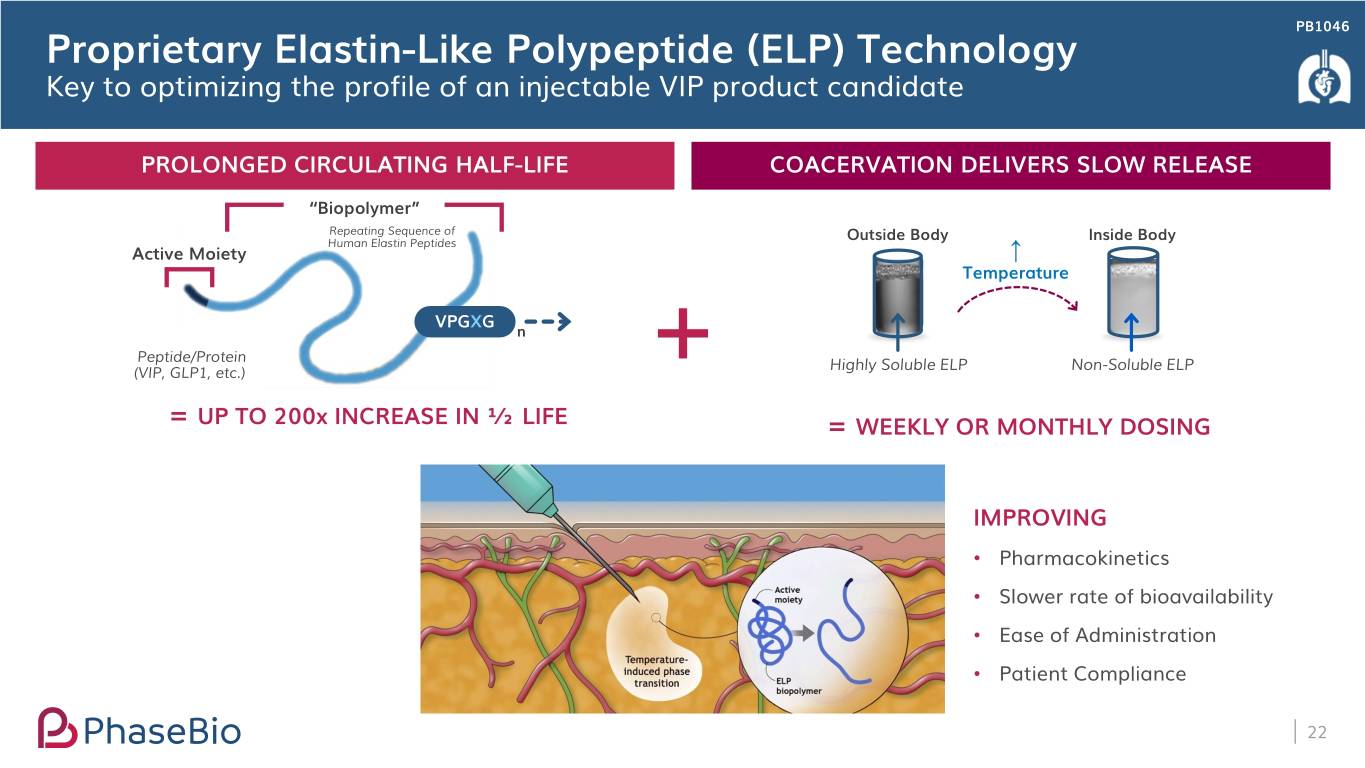
PB1046 Proprietary Elastin-Like Polypeptide (ELP) Technology Key to optimizing the profile of an injectable VIP product candidate PROLONGED CIRCULATING HALF-LIFE COACERVATION DELIVERS SLOW RELEASE “Biopolymer” Repeating Sequence of Human Elastin Peptides Outside Body Inside Body Active Moiety ↑ Temperature VPGXG n Peptide/Protein Highly Soluble ELP Non-Soluble ELP (VIP, GLP1, etc.) = UP TO 200x INCREASE IN ½ LIFE = WEEKLY OR MONTHLY DOSING IMPROVING • Pharmacokinetics • Slower rate of bioavailability • Ease of Administration • Patient Compliance 22
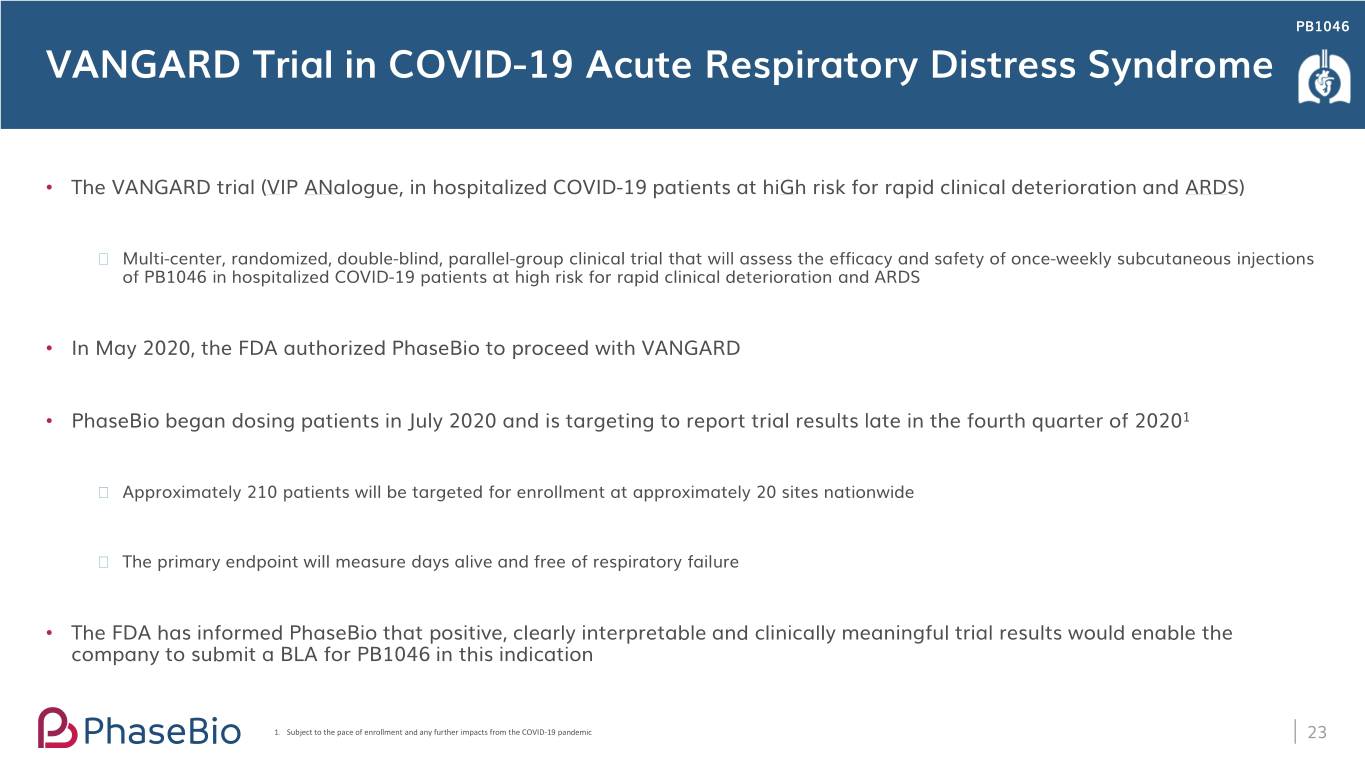
PB1046 VANGARD Trial in COVID-19 Acute Respiratory Distress Syndrome • The VANGARD trial (VIP ANalogue, in hospitalized COVID-19 patients at hiGh risk for rapid clinical deterioration and ARDS) ⎯ Multi-center, randomized, double-blind, parallel-group clinical trial that will assess the efficacy and safety of once-weekly subcutaneous injections of PB1046 in hospitalized COVID-19 patients at high risk for rapid clinical deterioration and ARDS • In May 2020, the FDA authorized PhaseBio to proceed with VANGARD • PhaseBio began dosing patients in July 2020 and is targeting to report trial results late in the fourth quarter of 20201 ⎯ Approximately 210 patients will be targeted for enrollment at approximately 20 sites nationwide ⎯ The primary endpoint will measure days alive and free of respiratory failure • The FDA has informed PhaseBio that positive, clearly interpretable and clinically meaningful trial results would enable the company to submit a BLA for PB1046 in this indication 1. Subject to the pace of enrollment and any further impacts from the COVID-19 pandemic 23
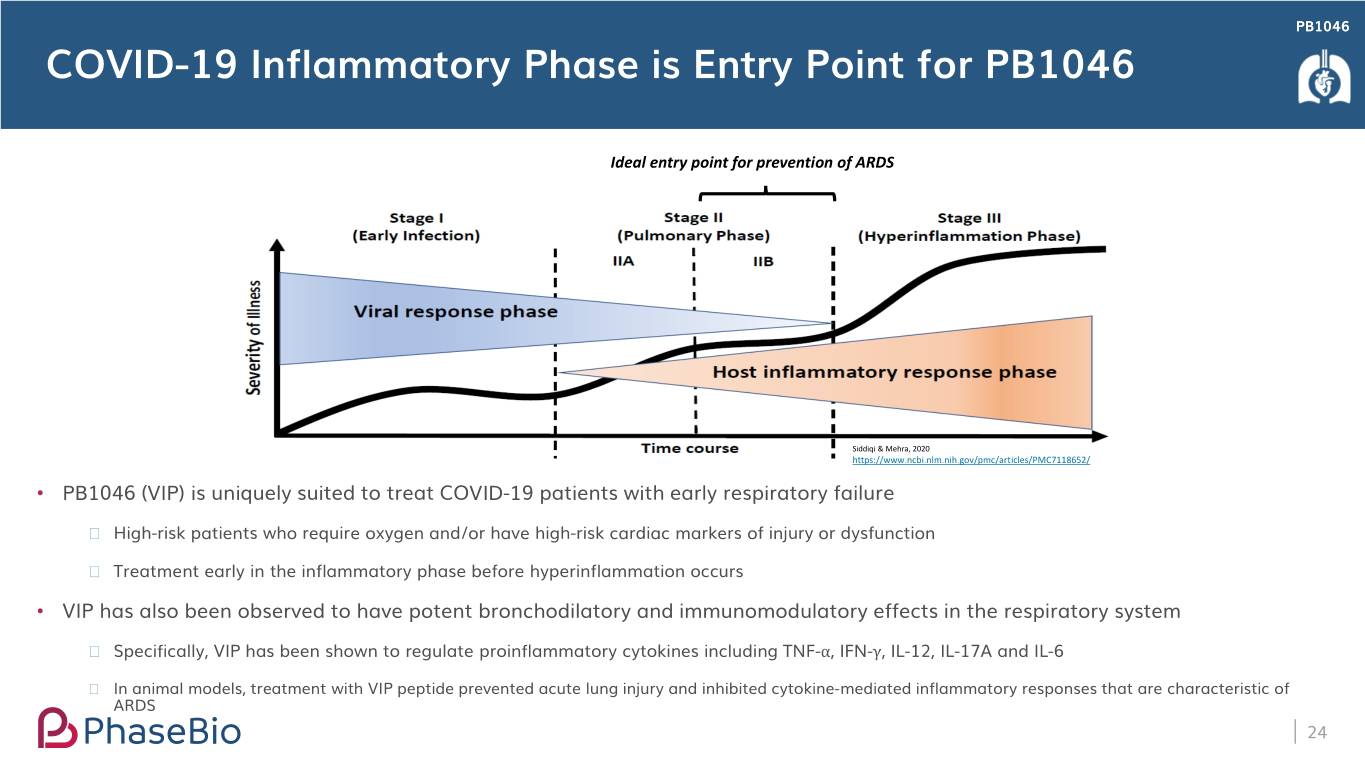
PB1046 COVID-19 Inflammatory Phase is Entry Point for PB1046 Ideal entry point for prevention of ARDS Siddiqi & Mehra, 2020 https://www.ncbi.nlm.nih.gov/pmc/articles/PMC7118652/ • PB1046 (VIP) is uniquely suited to treat COVID-19 patients with early respiratory failure ⎯ High-risk patients who require oxygen and/or have high-risk cardiac markers of injury or dysfunction ⎯ Treatment early in the inflammatory phase before hyperinflammation occurs • VIP has also been observed to have potent bronchodilatory and immunomodulatory effects in the respiratory system ⎯ Specifically, VIP has been shown to regulate proinflammatory cytokines including TNF- , IFN- , IL-12, IL-17A and IL-6 ⎯ In animal models, treatment with VIP peptide prevented acute lung injury and inhibited cytokineα -mediatedγ inflammatory responses that are characteristic of ARDS 24
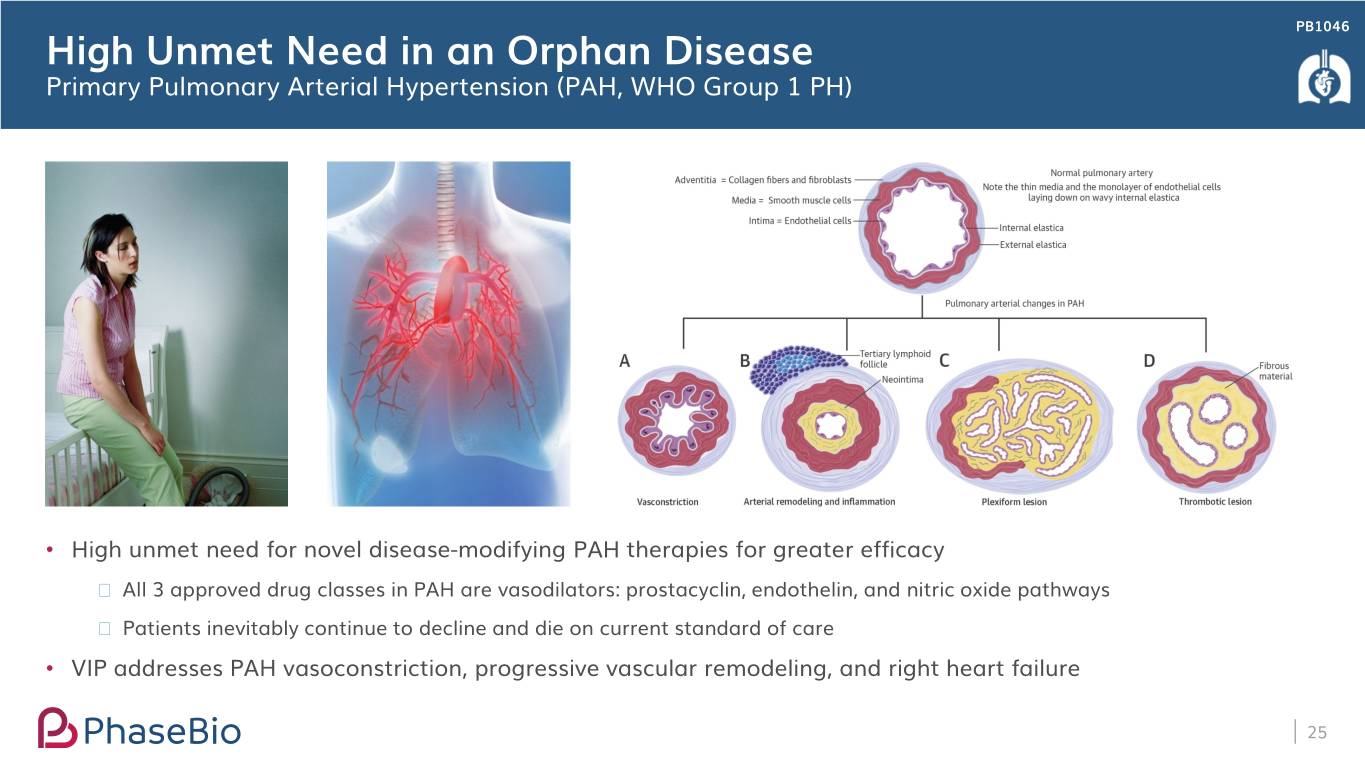
PB1046 High Unmet Need in an Orphan Disease Primary Pulmonary Arterial Hypertension (PAH, WHO Group 1 PH) • High unmet need for novel disease-modifying PAH therapies for greater efficacy ⎯ All 3 approved drug classes in PAH are vasodilators: prostacyclin, endothelin, and nitric oxide pathways ⎯ Patients inevitably continue to decline and die on current standard of care • VIP addresses PAH vasoconstriction, progressive vascular remodeling, and right heart failure 25
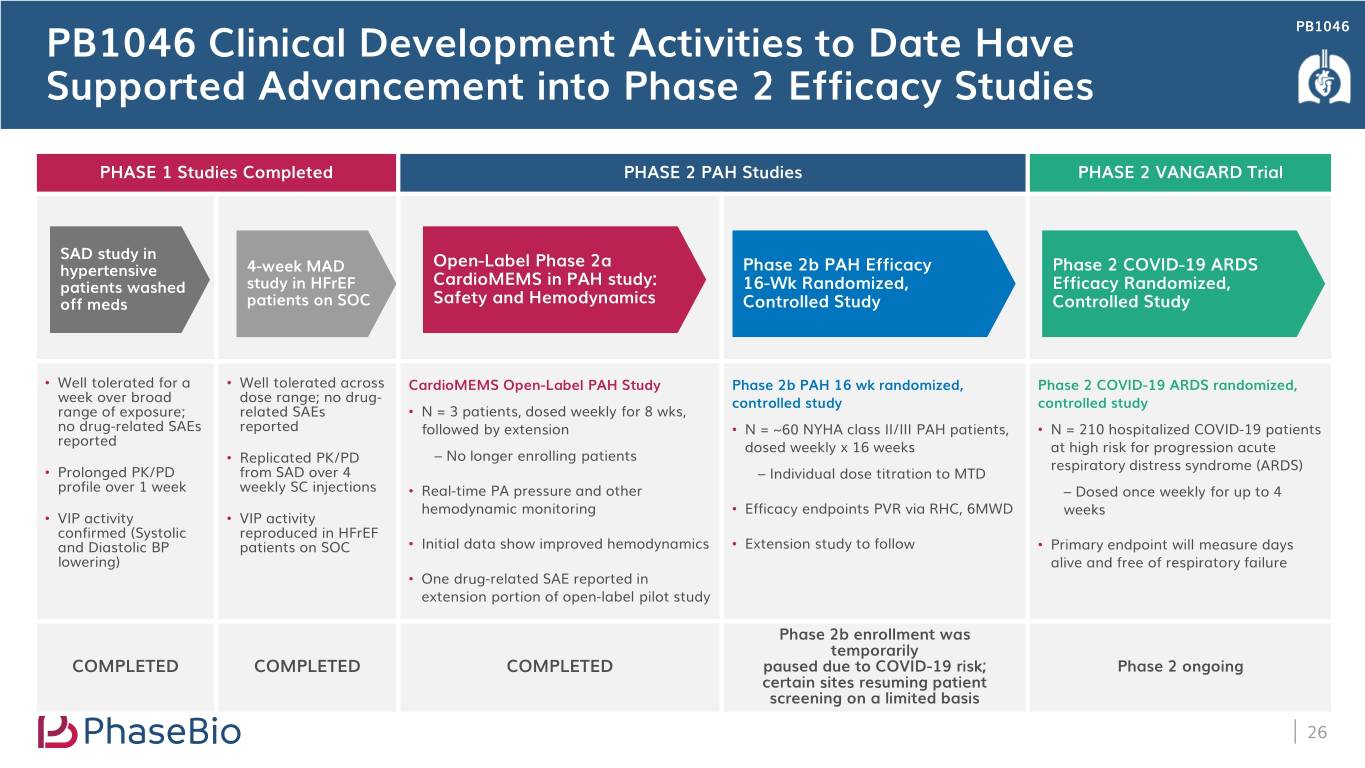
PB1046 PB1046 Clinical Development Activities to Date Have Supported Advancement into Phase 2 Efficacy Studies PHASE 1 Studies Completed PHASE 2 PAH Studies PHASE 2 VANGARD Trial SAD study in Open-Label Phase 2a hypertensive 4-week MAD Phase 2b PAH Efficacy Phase 2 COVID-19 ARDS patients washed study in HFrEF CardioMEMS in PAH study: 16-Wk Randomized, Efficacy Randomized, off meds patients on SOC Safety and Hemodynamics Controlled Study Controlled Study • Well tolerated for a • Well tolerated across CardioMEMS Open-Label PAH Study Phase 2b PAH 16 wk randomized, Phase 2 COVID-19 ARDS randomized, week over broad dose range; no drug- controlled study controlled study range of exposure; related SAEs • N = 3 patients, dosed weekly for 8 wks, no drug-related SAEs reported followed by extension • N = ~60 NYHA class II/III PAH patients, • N = 210 hospitalized COVID-19 patients reported dosed weekly x 16 weeks at high risk for progression acute Replicated PK/PD – No longer enrolling patients • respiratory distress syndrome (ARDS) • Prolonged PK/PD from SAD over 4 – Individual dose titration to MTD profile over 1 week weekly SC injections • Real-time PA pressure and other – Dosed once weekly for up to 4 hemodynamic monitoring • Efficacy endpoints PVR via RHC, 6MWD weeks • VIP activity • VIP activity confirmed (Systolic reproduced in HFrEF and Diastolic BP patients on SOC • Initial data show improved hemodynamics • Extension study to follow • Primary endpoint will measure days lowering) alive and free of respiratory failure • One drug-related SAE reported in extension portion of open-label pilot study Phase 2b enrollment was temporarily COMPLETED COMPLETED COMPLETED paused due to COVID-19 risk; Phase 2 ongoing certain sites resuming patient screening on a limited basis 26
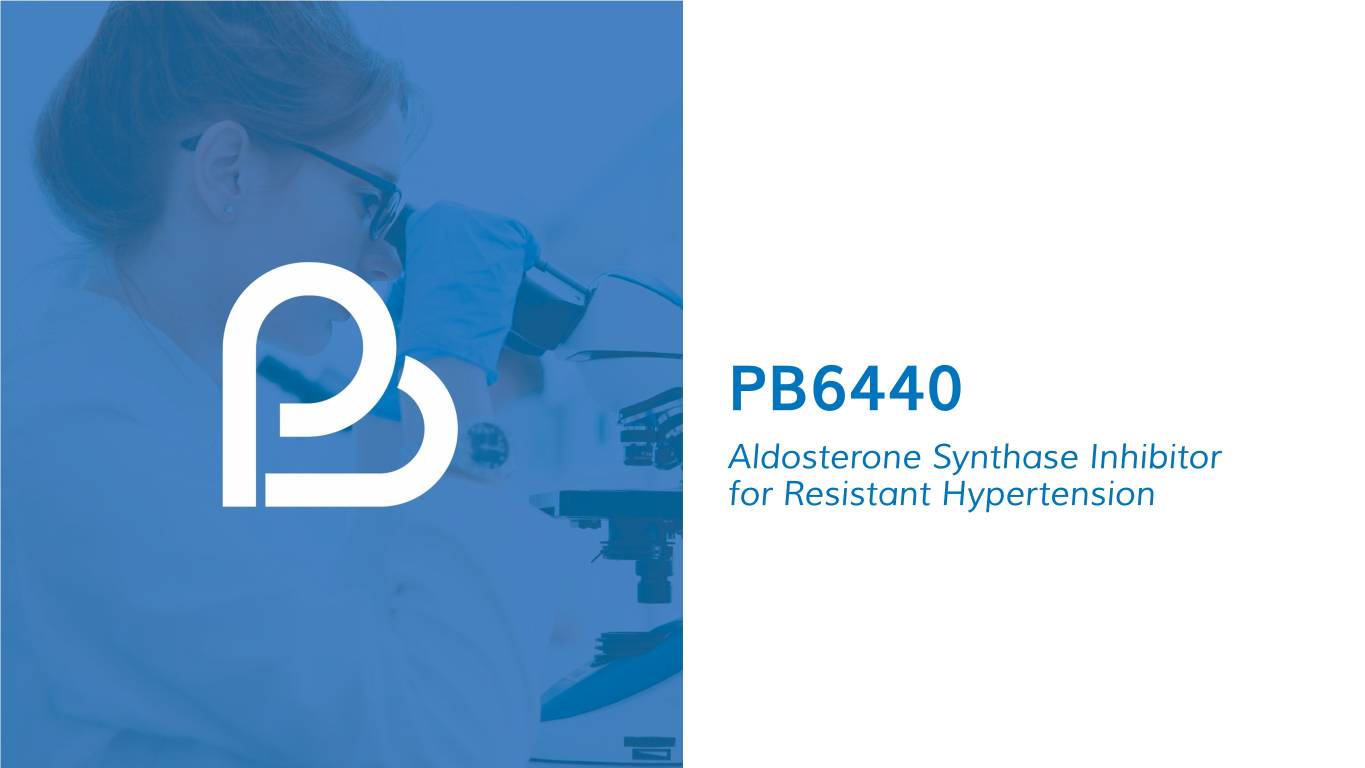
PB6440 Aldosterone Synthase Inhibitor for Resistant Hypertension
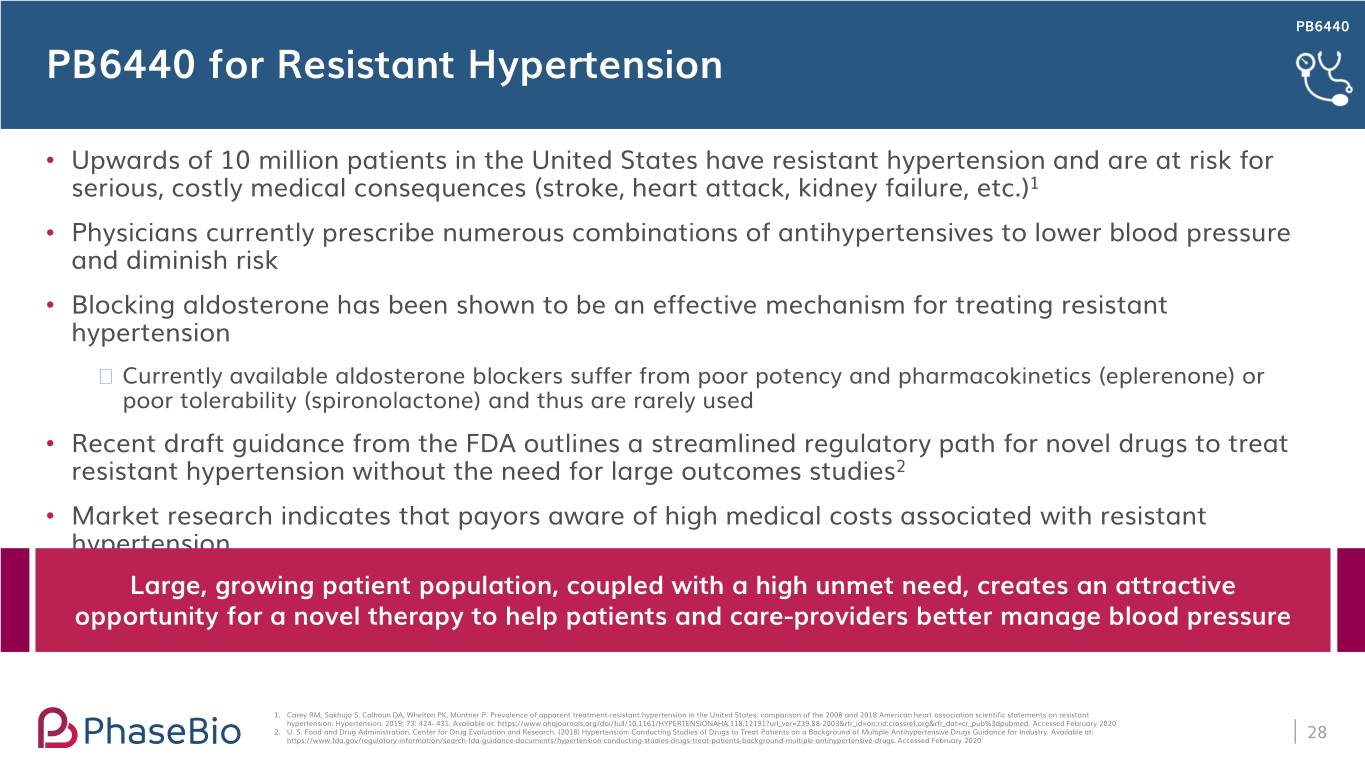
PB6440 PB6440 for Resistant Hypertension • Upwards of 10 million patients in the United States have resistant hypertension and are at risk for serious, costly medical consequences (stroke, heart attack, kidney failure, etc.)1 • Physicians currently prescribe numerous combinations of antihypertensives to lower blood pressure and diminish risk • Blocking aldosterone has been shown to be an effective mechanism for treating resistant hypertension ⎯ Currently available aldosterone blockers suffer from poor potency and pharmacokinetics (eplerenone) or poor tolerability (spironolactone) and thus are rarely used • Recent draft guidance from the FDA outlines a streamlined regulatory path for novel drugs to treat resistant hypertension without the need for large outcomes studies2 • Market research indicates that payors aware of high medical costs associated with resistant hypertension Large, growing patient population, coupled with a high unmet need, creates an attractive opportunity for a novel therapy to help patients and care-providers better manage blood pressure 1. Carey RM, Sakhuja S, Calhoun DA, Whelton PK, Muntner P. Prevalence of apparent treatment‐resistant hypertension in the United States: comparison of the 2008 and 2018 American heart association scientific statements on resistant hypertension. Hypertension. 2019; 73: 424‐ 431. Available at: https://www.ahajournals.org/doi/full/10.1161/HYPERTENSIONAHA.118.12191?url_ver=Z39.88-2003&rfr_id=ori:rid:crossref.org&rfr_dat=cr_pub%3dpubmed. Accessed February 2020 2. U. S. Food and Drug Administration. Center for Drug Evaluation and Research. (2018) Hypertension: Conducting Studies of Drugs to Treat Patients on a Background of Multiple Antihypertensive Drugs Guidance for Industry. Available at: https://www.fda.gov/regulatory-information/search-fda-guidance-documents/hypertension-conducting-studies-drugs-treat-patients-background-multiple-antihypertensive-drugs. Accessed February 2020 28
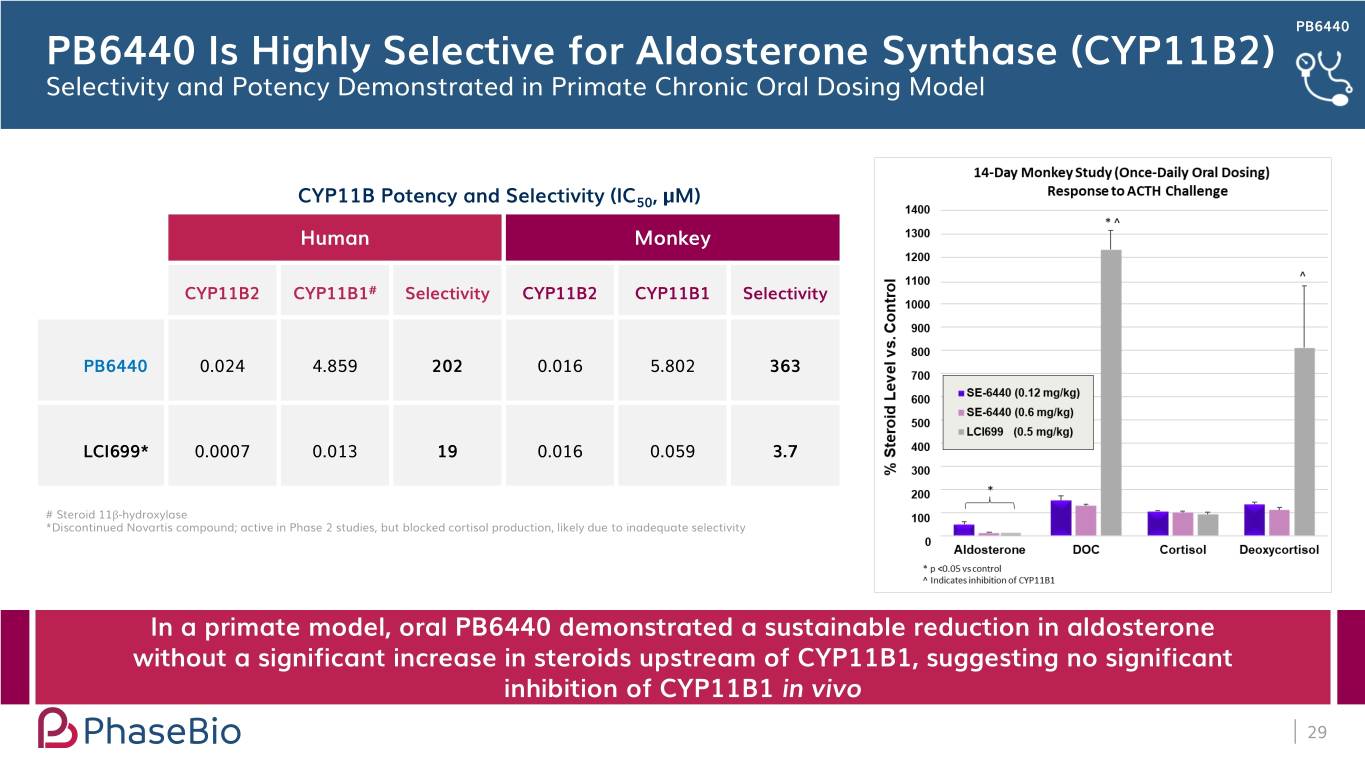
PB6440 PB6440 Is Highly Selective for Aldosterone Synthase (CYP11B2) Selectivity and Potency Demonstrated in Primate Chronic Oral Dosing Model CYP11B Potency and Selectivity (IC50, µM) Human Monkey CYP11B2 CYP11B1# Selectivity CYP11B2 CYP11B1 Selectivity PB6440 0.024 4.859 202 0.016 5.802 363 LCI699* 0.0007 0.013 19 0.016 0.059 3.7 # Steroid 11 -hydroxylase *Discontinued Novartis compound; active in Phase 2 studies, but blocked cortisol production, likely due to inadequate selectivity β In a primate model, oral PB6440 demonstrated a sustainable reduction in aldosterone without a significant increase in steroids upstream of CYP11B1, suggesting no significant inhibition of CYP11B1 in vivo 29





























